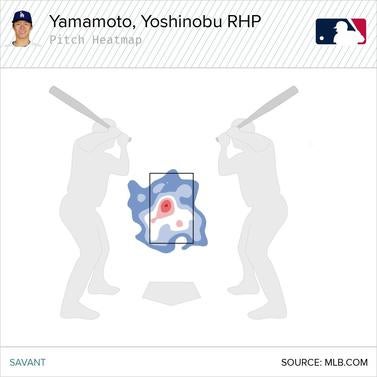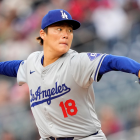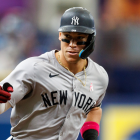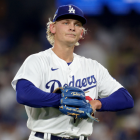
Yoshinobu Yamamoto's introduction to Major League Baseball could not have gone worse. The $325 million man got ambushed for five runs in just one inning against the San Diego Padres in Game 2 of the Seoul Series on March 21. No one seemed to pitch well in the Seoul Series -- there were 33 runs scored in the two games -- though Yamamoto's outing was especially rough.
"I feel regret that I just couldn't keep the team in the game from the get-go. I do feel a responsibility for it," Yamamoto said through an interpreter after his MLB debut (via MLB.com). "... I wasn't able to execute a pitch from the stretch. I know how to fix it, and I'm going to talk to my pitching coaches Mark (Prior) and Connor (McGuiness) and fix it for my next outing."
First impressions matter and there has been an air of disappointment surrounding Yamamoto since his rough debut in South Korea. But, six starts into his season, he owns a 3.54 ERA with 37 strikeouts and only six walks in 28 innings. Three of his six starts have been scoreless, and he's allowed seven runs (six earned) total since giving up five runs in his debut.
Against an admittedly weak Washington Nationals lineup, Yamamoto had his best MLB start last Thursday, striking out seven in six scoreless innings. Opponents are hitting .224 with a .267 on-base percentage against him, and that includes Seoul.
"It was probably his best start he has had with us. And actually, the last two have been really good," Los Angeles Dodgers manager Dave Roberts said after Yamamoto's last start (via MLB.com). "... I think that these last two shows that when he executes his pitches, he can get anyone out. I expect this to kind of dovetail into more confidence."
The Dodgers gave Yamamoto the largest pitching contract in history because he is only 25 and because he is arguably the most decorated pitcher in the history of Japan's Nippon Professional Baseball. Yamamoto had a 1.72 ERA in seven seasons with the Orix Buffaloes and he won three straight MVPs and Eiji Sawamura Awards (NPB's Cy Young equivalent) from 2021-23.
That all said, there was always likely to be an adjustment period for Yamamoto in Major League Baseball. In addition to facing better hitters, the baseball itself is different, the schedule and the travel are more demanding, and it's an entirely new culture too. Relocating to another country for work is not easy, even when you're well-compensated.
With Yamamoto's first month as an MLB pitcher in the books, here's what you need to know about the right-hander as he begins to round into form for the NL West-leading Dodgers.
1. His curveball and splitter are standout pitches
Multiple teams offered Yamamoto $300-plus million because he's so young and also because he features an impressive array of secondary pitches. The curveball and splitter are his go-tos, though he's also mixed in a few cutters. Yamamoto has not used his slider much (he's thrown only one in six starts), which isn't surprising. It wasn't a feature pitch for him in NPB.
The curveball and splitter both sport above-average whiff rates (i.e. misses per swing) through six starts, which is consistent with the scouting report and his track record. Here are the numbers:
| Velocity | Spin | Whiff% | Exit velocity | |
|---|---|---|---|---|
Yamamoto's curveball | 78.2 mph | 2,690 rpm | 36.4% | 81.2 mph |
MLB average curveball | 79.1 mph | 2,552 rpm | 29.5% | 86.6 mph |
| Velocity | Spin | Whiff% | Exit velocity | |
Yamamoto's splitter | 89.6 mph | 1,277 rpm | 36.9% | 85.5 mph |
MLB average splitter | 86.1 mph | 1,325 rpm | 36.2% | 87.4 mph |
Spin rate is a bit tricky because high spin is good for a curveball (it creates "snap") and low spin is good for a splitter (it creates "tumble"). High spin is not automatically good for each pitch type. Yamamoto's spin rates are better than average on both the curve and splitter, and that's a wide velocity range. He makes hitters cover the upper-70s (curveball) to the upper-90s (fastball).
Yamamoto is top 25 in both curveball and splitter whiff rate, and he's been able to suppress hard contact with both pitches. Hitters who have managed to get the bat on either the curveball or splitter haven't been able to hit them all that hard. Yamamoto's thrown approximately 28% curveballs and 27% splitters, so this is 55% of his arsenal right here. It's two standout pitches.
Through six starts, Yamamoto's approach is very similar to Masahiro Tanaka's. Tanaka threw roughly 27% splitters and 29% sliders during his time with the New York Yankees, or 56% of his total pitches. This is way the game is trending despite all-time high fastball velocity. More breaking balls, more offspeed pitches, fewer fastballs. Yamamoto is modern pitching personified.
2. The fastball is lacking
Lacking and maybe even a real problem. Yamamoto is not struggling with velocity -- his fastball has averaged 95.4 mph and topped out at 97.5 mph in 2024 -- but he is not fooling hitters with his fastball either. They've hit his heater pretty hard through six starts:
| Batting average | Slugging percentage | Whiff% | |
|---|---|---|---|
Yamamoto's fastball | .316 | .605 | 20.0% |
MLB average fastball | .246 | .411 | 21.8% |
Opponents have five singles and seven extra-base hits (five doubles and two homers) against Yamamoto's fastball, and they don't swing and miss often. The spin and movement are unremarkable. The velocity is good, but the carry at the top of the zone is not. For all intents and purposes, Yamamoto has a below-average heater with few under-the-hood reasons to believe it'll get better.
There is, however, one reason to believe Yamamoto's heater will perform better moving forward: location. Simply put, Yamamoto is throwing his fastball over the heart of the plate far too often. Here are his fastball locations:

Yamamoto did a much better job pitching to the edges of the strike zone with this fastball against the Nationals last week and, not coincidentally, it was his best MLB start. Hitters have told Yamamoto he needs to stay out of the middle of the plate with his heater. They are hammering the pitch. It's just a matter of consistently executing the fastball, something he's not yet done.
"When he throws it where he should throw it, it certainly plays as an elite fastball," Roberts said last Thursday (via the Los Angeles Times).
3. He's a master at getting called strikes
Yamamoto came over from NPB with a reputation for well-above-average command -- that's one reason to believe he'll locate his fastball better moving forward -- and that has shown up in his MLB-best called strike rate. He has the highest called strike rate in the league and one of the highest called strike plus whiff rates. Here are the leaderboards:
| Called strikes (CStr%) | Called strikes + whiffs (CSW%) |
|---|---|
1. Yoshinobu Yamamoto: 21.9% | 1. Jack Flaherty: 34.9% |
2. Chris Bassitt: 21.1% | 2. Yoshinobu Yamamoto: 34.2% |
3. Logan Webb: 21.0% | 3. Jared Jones: 33.7% |
4. Aaron Civale: 20.6% | 4. Chris Sale: 32.9% |
5. Michael King: 20.5% | 5. Sonny Gray: 32.7% |
MLB average: 16.8% | MLB average: 27.6% |
CStr% and CSW% are simple yet very effective measures of the ability to command the strike zone. There is an obvious benefit to consistently recording strikes without the hitter putting the bat on the ball. Even foul balls are a negative for a pitcher. Foul balls can't go for hits, but they can prolong at-bats in two-strike counts.
One month into his MLB career, Yamamoto has been as good as anyone at getting strikes without the hitter making contact. He is new to the league, so everyone is seeing him for the first time and we'll have to see how his CStr% and CSW% evolve throughout the season, though the ability to command the zone was expected. Yamamoto did it throughout his career in NPB.
4. He's yet to start on normal rest
Pitchers in Japan typically start once a week, not once every five days, and that requires an enormous adjustment. Pitching comes with so much inherent injury risk as it is. Going from pitching once a week to pitching once every five days means less recovery time between starts, and also a new between-starts routine. Even for a 25-year-old like Yamamoto, it's a big change.
To aid in that adjustment, the Dodgers have simply not had Yamamoto start on normal rest. He's had at least one extra day of rest between each of his starts, and four times he had at least two extra days of rest. Here's his schedule:
| Days of rest | Innings | Pitches | |
|---|---|---|---|
March 21 vs. San Diego Padres | 7 | 1 | 43 |
March 30 vs. St. Louis Cardinals | 8 | 5 | 68 |
April 6 at Chicago Cubs | 6 | 5 | 80 |
April 12 vs. San Diego Padres | 5 | 5 | 91 |
April 19 vs. New York Mets | 6 | 6 | 99 |
April 25 at Washington Nationals | 5 | 6 | 97 |
The Seoul Series meant the Dodgers (and Padres) had an unusual spring training and both teams took special care to build up their starters for those games and the regular season. For Yamamoto, that careful build up continued into the regular season. It wasn't until his fourth start (third start in the United States) that he reached the 90-pitch plateau.
A slow build up and giving a starter who is coming over from NPB so much extra rest is not unprecedented. The Mets did the same thing with Kodai Senga last season. Senga made each of his first 10 starts with extra rest, and only three of his 29 starts came on normal rest. They were spread out too, all several weeks apart. Senga never made back-to-back starts on normal rest.
Early season off-days have helped the Dodgers give Yamamoto (and all their starters, really) extra rest, though they've also had to insert a few bullpen games into the rotation to make it work. Yamamoto's pitching schedule has been disruptive at times, sure, but the Dodgers have a lot invested in this guy. They are doing what they deem prudent to protect him.
It's unknown when the Dodgers will let Yamamoto start on normal rest, or if they even will. They might just go the entire season giving him extra rest. That seems unlikely because they'll want Yamamoto to pitch as often as possible in the postseason, and you don't want the first time he starts on normal rest to be in a game of that magnitude, but I suppose it's possible.
One month into his MLB career, Yamamoto has pitched well overall, and especially since his disastrous debut in Seoul. He's leaning on his curveball and splitter because his fastball is getting hit hard, he's doing great work getting strikes, and he's had plenty of rest. Yamamoto has not been an instant ace, but he has been effective. There are promising signs abound.






















